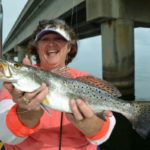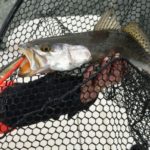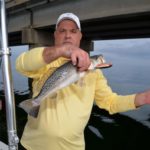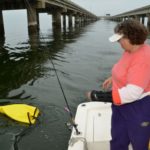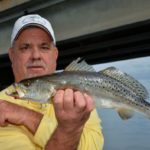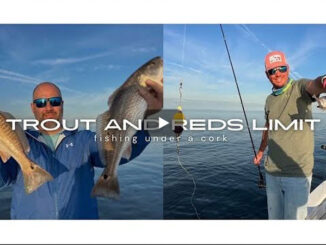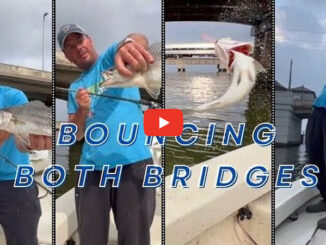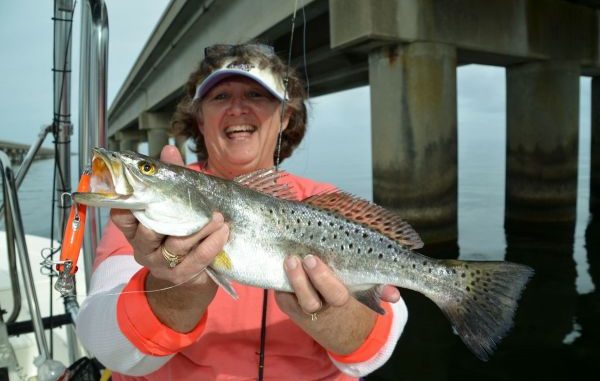
It took some practice, but this couple finally figured out how to troll up big Lake Pontchartrain trout — and now they live for this month, when they know the fish will eat.
“That’s a big trout, Momma. Be careful! Take your time, Momma. Bring him this way.”
Gravelly-voiced Chuck Cristina was issuing orders like Lord Admiral Horatio Nelson, only with an old-time New Orleans accent.
The recipient of the orders, his bubbly wife and regular fishing partner Zelita “Z” Cristina, assured him with her own honey-dripping Southern accent that she knew what she was doing.
Chuck could only launch a crooked grin in reply.
The Cristinas were fishing under a bridge — a big bridge.
The two side-by-side spans of the Lake Pontchartrain Causeway are each 23.8 miles long. That’s 251,803 feet of fish-holding water. A grand total of 9,500 bridge pilings are set in that stretch, each providing structure attractive to speckled trout.
The Cristinas — self-confessed speckled trout specialists — were trolling there for that very reason. They have their trout fishing all figured out.
The mid 50-ish couple fishes the big lake from January to Memorial Day each year. From Memorial Day to Labor Day they concentrate on Grand Isle. After Labor Day, they are back in Lake Pontchartrain, most likely fishing under the causeway.
Much of their strategy is based around competing in the Louisiana Coastal Conservation Association STAR.
Lake Pontchartrain holds big trout, but trout fishing is weak in the lake during the hottest months of the year, just when Grand Isle is at its prime.
Chuck explained their Grand Isle summers.
“We own a camp at Grand Isle, and being able to keep a boat in the water is very convenient. No trailering,” he said. “Also, Grand Isle is in a different division of the STAR, so we don’t have to compete against the big-trout specialists at Venice and in Lake Pontchartrain.”
Their strategy paid off in 2009, when Chuck won the Southeast Division of the tournament with a 7.54-pound speck while wade-fishing in island’s surf.
“I went out with a bucket of minnows and came back with a boat,” he said.
In 2014, Z temporarily led the Women’s Division of this highly competitive tournament.
But this was December, and Chuck and Z were chasing the Lake Pontchartrain’s big trout.
They have lived for this moment in their lives. Both are recent retirees, and both are in relatively good health. They own a fishing camp, and they own a BlackJack bay boat.
The couple always fishes together.
“That’s because nobody wants to fish with him,” Z laughed, hooking a thumb toward Chuck.
He huffed his chest out in mock bravado.
“That’s because I intimidate them,” he said. “I’m not being narcissistic (the big word sounded funny when delivered in a New Orleans Yat accent), but I’m just good.”
He glanced at me taking notes.
“Don’t print that!” Chuck commanded.
The day started leisurely at 9 a.m. at the Williams Boulevard Boat Launch in Kenner.
“If air temperatures are comfortable, we will launch at 7 a.m.,” Chuck said. “If it’s cold, we leave at 9 or 10 a.m. The fish usually bite all day.
At what at first glance appeared to be a random spot between the bridge spans, Chuck throttled back his boat to an idle and the anglers went to separate corners on the stern to set one of a pair of drift socks — large plastic umbrella-like contraptions meant to slow the boat’s idle speed even slower.
From there, each had a job. While Chuck concentrated on piloting the boat to avoid the bridge’s pilings and other boats, Z set and controlled the lines (typically three of them), one in a rod holder in each gunnel and one in the center in a holder mounted on the boat seat.
“When fishing gets slow, we may put out a fourth one stuck in a holder in the T-top,” Chuck said.
When the bite is good, as it got later in the day, they reduce their lines to two.
But no matter how many lines are out, all their trolling is done “dead stick,” with rods in holders instead of their hands.
Z said each rod was what she called the “bottom test.” As husband Chuck kept the boat moving straight forward at idle speed to prevent the lure’s hooks from tangling in the line, she slowly let line out from the reel until she felt the lure bouncing on the bottom.
Then she reeled in enough line to keep it running just off the bottom.
“I watch the depth sounder,” she explained. “If it is marking fish on the bottom, I want to fish just off the bottom. If it’s marking fish shallower, I will take up more line or we will pick up one of the drift socks.”
After the lines were set, the couple relaxed.
“You have to have patience to troll,” Chuck counseled. “We are targeting trophy fish doing this. We have been trolling three years, and our biggest so far is 6 ½ pounds.
“We catch specks over 5 pounds all the time, especially in the spring — late February through April, and even May. Our favorite water temperatures are 55 to 65 degrees. When the lake gets hot, the fish shut down.
“Fall is also good when the lake’s waters fall into the 60s, typically beginning in late October. That bite lasts until water temperature hits 50 degrees, although it starts slowing down below 55 degrees.
Wind plays a factor in fishing.
“A west wind will screw fishing up,” Chuck rumbled.
“It’s the worst wind,” Z agreed.
“A light east wind is best,” Chuck said.
It didn’t take long for the first bite.
There was nothing subtle about the strike or the ones that followed it; the rod arched deeply and thumped, prompting a Chinese fire drill.
While one person — usually Z — played the fish, the other swiftly reeled in the unstruck lines.
“It’s important to get these lines in,” Chuck yelled as he reeled furiously. “A big trout can really cause chaos with the other lines out.”
When Z fought the fish close to the boat, Chuck shifted to his other job — net man.
While treble hooks invariably tangle in a landing net, the couple prefer that to swinging any but the smallest fish into the boat to thrash around wildly with its face full of wicked hooks.
While Chuck always steers the boat, their other roles aren’t engraved in stone and they will often switch their other jobs.
After about 10 fish, I asked for the secret.
“It’s all about the boat driving,” Chuck deadpanned, while firmly gripping the steering wheel.
“Oh yeah,” Z retorted, “what about proper line setting?”
“Well, it’s a little of that too,” Chuck softly confessed, studiously avoiding his wife’s gaze.
Fishing with these two was fun. They kept me laughing.
But Chuck turned deadly serious when they got a fish on. He worked like he had three arms to get the other lines up, avoid the boat drifting into a bridge piling, netting the fish and then resetting the lines.
The fish were showing a decided preference for the gold-and-orange MirrOlure, so they rigged all three lines with the baits.
As the day wore on, the fish bit better. Perhaps the water was warmer, although it seemed hard to believe that the day’s sun warmed the water 16 feet deep.
When the bite got stronger, the Cristinas reduced the number of lines in the water to two.
“When they are really biting, it’s best to avoid tangles by having only two lines out,” Chuck explained.
Even though it was December, the weather was really mellow — generally overcast, with patches of sun breaking through at times. It was dead calm, and the water was slick calm.
The fish flashed lavender-tinted silver as they came to the surface. Every speck on their body was visible 5 feet down.
Chuck was happy with everything but the size of the fish, which would have tickled most fishermen fishing anywhere else.
“Where’s your momma?” he yelled at a 17-incher as he put it in the box.
In spite of his growls, it wasn’t hard to notice they didn’t catch any throw-backs.
None were even close.
